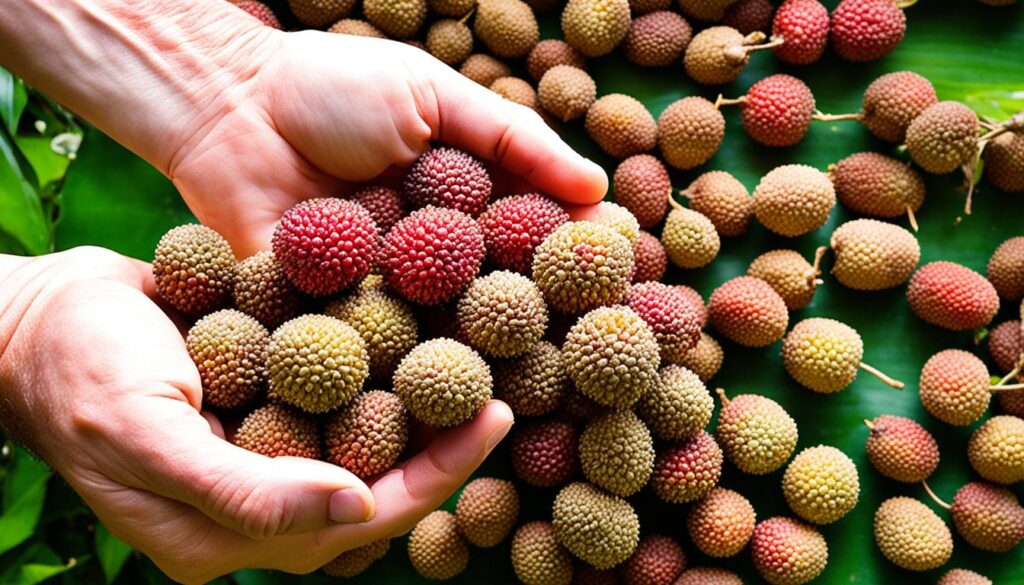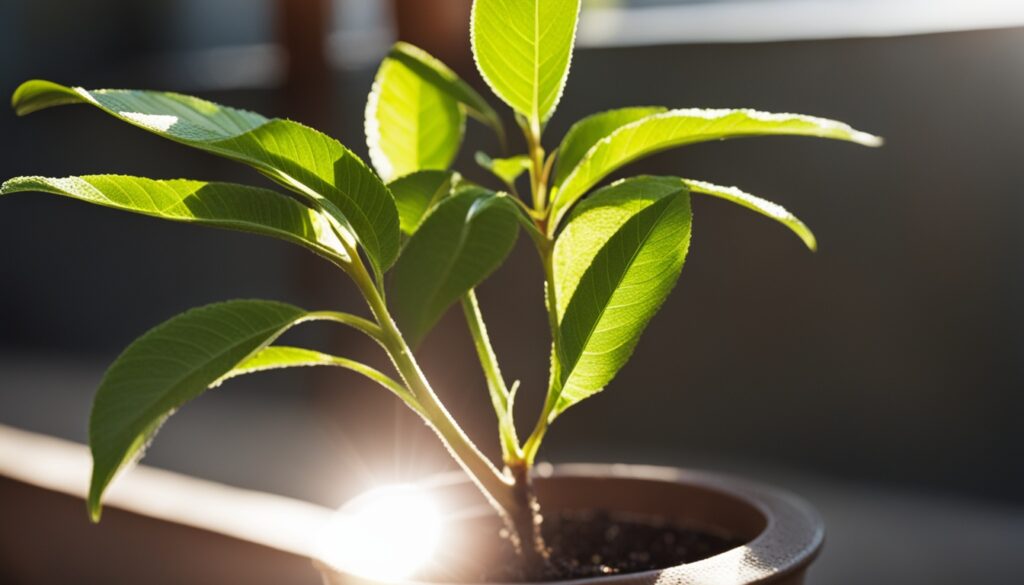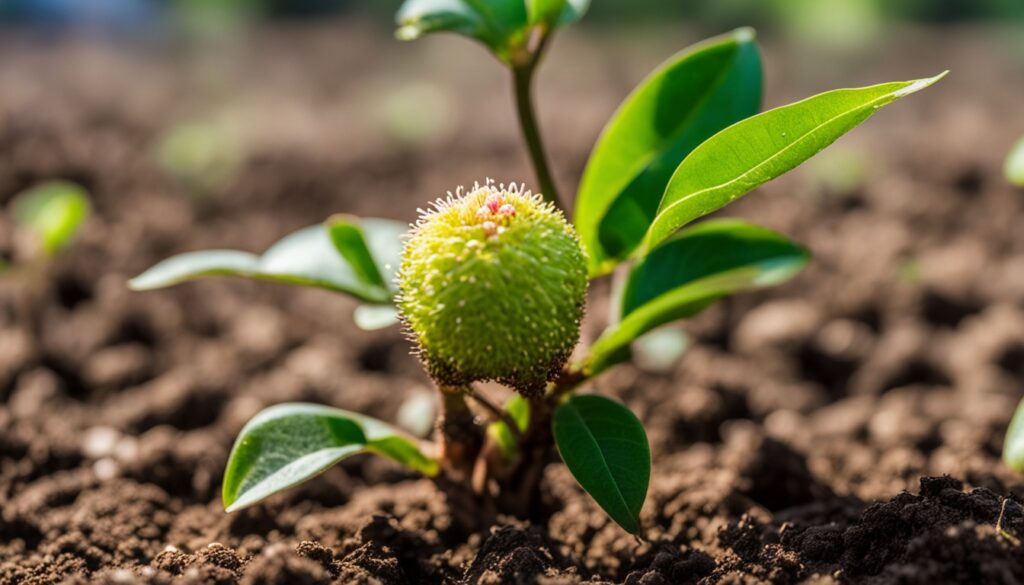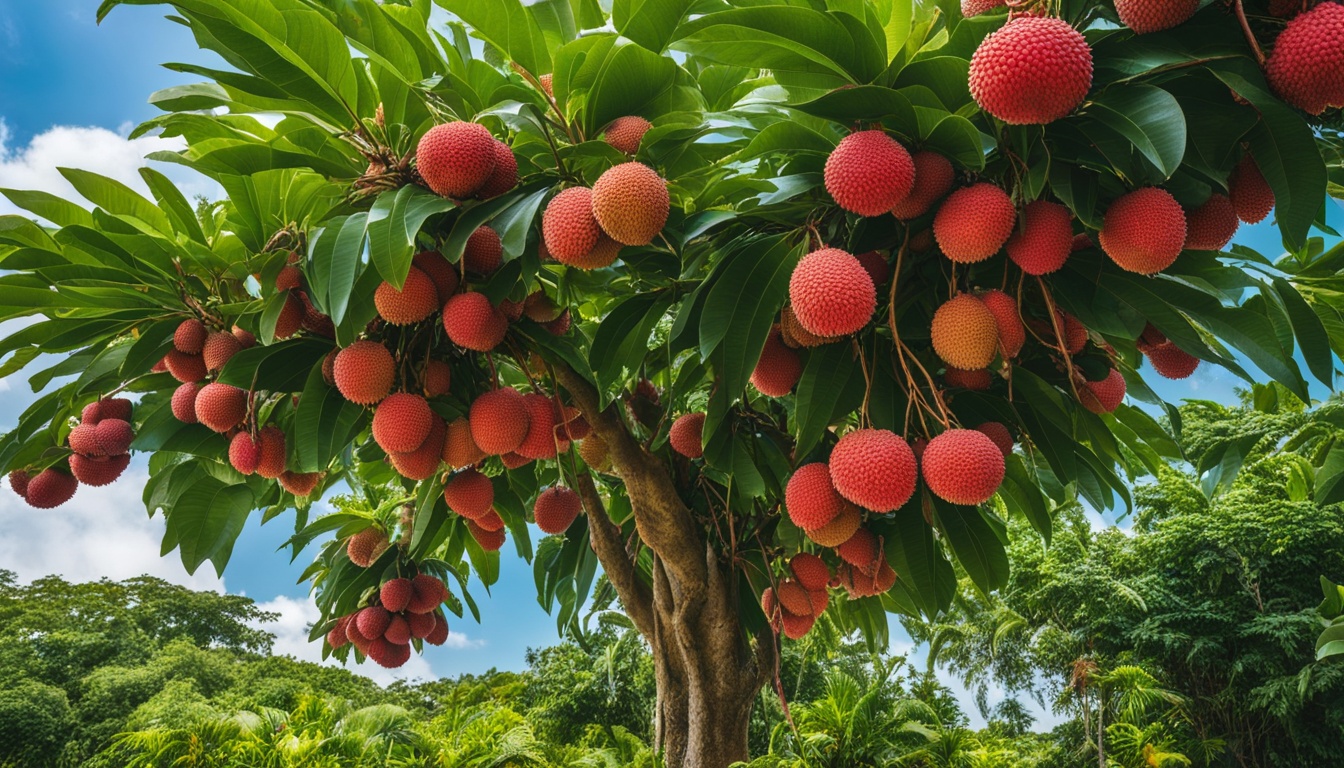Growing a lychee tree from seed is a rewarding hobby for garden lovers. This guide will help you grow your own lychee tree, from picking the right seeds to transplanting and care. Lychees are tasty and nutritious fruits you can grow at home with the right methods. By following these steps, you can grow and care for your lychee tree. This way, you’ll have fresh lychees right at home.
Lychee trees can reach 10 to 15 meters tall in the wild. Each flower cluster can have 2 to 20 fruits that ripen in 60 to 80 days. With proper care, you can enjoy your lychee tree’s fruits for many years. Let’s explore how to grow a lychee tree from a seed.
Seed Selection and Preparation
Choosing the right lychee seeds is key to growing a healthy lychee tree. Here are the steps for lychee seed selection and preparation to get you started.
Source
Get your lychee seeds from fresh, ripe fruits in late spring and early summer. Choose fruits that are plump and brightly colored. Make sure they are free of any blemishes or decay. The fruit’s quality shows how good the seeds will be.
Quality Check
- Look for lychee seeds without any damage or discoloration.
- Choose seeds that are plump, firm, and have no blemishes.
- Stay away from shriveled, cracked, or moldy seeds. They are less likely to grow.
Freshness
Use fresh lychee seeds right after harvesting for the best germination chance. Older seeds may not germinate well and take longer to do so.
Handling
Be gentle with the delicate lychee seeds to avoid damage. Carefully take the seeds out of the fruit and rinse them under cool water. This removes any leftover fruit flesh.
Cleaning
Clean the lychee seeds well by rinsing them under cool water. This step gets rid of any fruit flesh or debris that could stop germination.
Soaking
Soak the cleaned lychee seeds in water for 24 hours. This softens the seed coat and starts the germination process. It prepares the seeds for planting.

By following these steps for lychee seed selection and preparation, you’ll set your lychee tree up for success from the start.
Germination
The journey to grow a vibrant lychee tree starts with germination. To help your lychee seeds succeed, focus on the container, soil mix, planting depth, moisture, warmth, and humidity. With patience and careful monitoring, you’ll see sprouts soon.
Container Choice
Begin with a small, well-draining container for your lychee seeds. This could be a seed starting tray, a pot, or a repurposed milk carton. The goal is to give the roots room to grow and the seedling to thrive early on.
Soil Mix
Choose a high-quality, well-draining soil mix for seed starting or potting. This ensures your lychee seeds get the best conditions to germinate and grow strong roots. Stay away from heavy, dense soils that can cause waterlogging and slow growth.
Planting Depth
Plant your lychee seeds about an inch deep in the soil. This depth offers protection and lets them get the warmth and moisture they need to germinate.
Moisture Control
Keeping the soil consistently moist but not waterlogged is key for germination. Check the soil moisture often with your finger and water gently to avoid disturbing the seeds.
Warmth Requirements
Lychee seeds love warm conditions, ideal between 75°F and 90°F (24°C and 32°C). Use a heat mat or a warm spot to create the perfect environment for germination.
Humidity
To keep the humidity high like lychee seeds prefer, cover the container with a clear plastic lid or bag. This maintains the moisture and helps the seeds sprout.
Patience is Essential
Germination time for lychee seeds can vary, so be patient. Don’t dig up the seeds to check progress, as it can disrupt the process.
Monitoring
Check the soil moisture and temperature often, and watch for signs of germination like the seed cracking and a sprout emerging. This careful watching lets you provide the right care as the seedling grows.
By following these steps and creating the right conditions, you’re on your way to successful lychee seed germination. With diligence and patience, you’ll soon have a thriving lychee seedling ready to grow into a beautiful tree.

Seedling Care
As the lychee seedling grows, it needs the right care for healthy growth. Managing its light exposure is key.
Light Exposure
Lychee seedlings do well with bright, indirect sunlight. This makes their stems strong and their leaves lush. Start with partial sun and slowly increase the light as the seedling gets bigger.
Transplanting
When the seedling has a few leaves and looks strong, it’s ready for a bigger pot or outside. Transplanting carefully is important for its growth.
To transplant, carefully take the seedling out of its pot without harming the roots. Put it in soil that drains well and is full of nutrients. Water it well, but make sure the soil isn’t too wet.
Remember, managing light and transplanting at the right time are key for your lychee seedling. With the right care, your lychee tree will grow well and reach its full potential.

how to grow a lychee tree from a seed
Importance of Growing Lychee from Seed
Growing a lychee tree from a seed is rewarding and educational. It takes longer than other methods, but it’s very fulfilling. The tree grown from a seed gets a strong root system, making it healthier and more resilient.
Indirect Sunlight Requirement
Lychee seedlings do well in bright, indirect sunlight. Give them plenty of filtered light and slowly increase direct sun as they grow. Don’t put the tree in too much direct sunlight, as it can burn the leaves and slow growth.
Adjusting Light Exposure
Watch how much light your lychee seedling needs and change it as needed. Move the plant to a brighter spot if its leaves look too long or pale. If the leaves are wilting or look bad, cut down on direct sunlight to keep the plant healthy.
Maintaining Proper Moisture Level
Keeping the soil moist is key for a healthy lychee tree. Make sure the soil is damp but not soaked, waiting for the top inch to dry before watering again. Deep, less frequent watering helps the roots grow strong.
Monitoring Watering Needs
Check the soil moisture often and change how often you water based on the weather and the plant’s growth. In hot, dry times, you might need to water more often to keep the tree from getting stressed.
Importance of Nutrient Balance
Lychee trees need the right mix of nutrients to grow well and produce fruit. Use a slow-release fertilizer with a balanced NPK ratio, like 10-10-10 or 12-12-12. This gives the tree the nitrogen, phosphorus, and potassium it needs.
Frequency of Fertilizer Application
Feed your lychee tree every 3-4 months when it’s growing. This keeps nutrients flowing steadily. Change how often you fertilize based on how the plant is doing and if it seems to need more or less nutrients.
Observing the Seedling’s Progress
Keep an eye on your lychee seedling’s growth and look for changes in its leaves and health. This helps you spot and fix any problems early. It lets the plant grow strong and eventually produce tasty lychees.

Conclusion
Growing a lychee tree from seed is rewarding for gardeners in the U.S. This guide shows you how to grow and care for your tree. From picking the right seeds to transplanting and maintenance, you’ll learn it all. With patience and the right care, you can enjoy delicious lychees from your tree.
Lychee trees are great for gardens and are good for your health. They are full of nutrients, antioxidants, and anti-inflammatory compounds. Eating lychees can lower the risk of chronic diseases and boost your health. They also help with digestion and weight control because of their fiber content.
To grow a lychee tree, pay attention to soil, moisture, sunlight, and nutrients. Mastering these will help your tree thrive. This guide is perfect for both experienced and new gardeners. With effort and a bit of luck, you’ll soon enjoy the tasty fruits of your labor.
FAQ
Where can I source lychee seeds?
Find fresh, ripe lychees in late spring and early summer. Choose plump, smooth fruits and carefully take out the seeds.
How do I prepare the lychee seeds for planting?
Rinse the seeds under cool water to get rid of any fruit flesh. Then, soak them in water for 24 hours. This softens the seed coat and starts germination.
What type of soil and container should I use to plant the lychee seeds?
Use a small container with well-draining soil for your lychee seeds. Plant them about an inch deep.
What temperature and humidity requirements do lychee seeds have for germination?
Keep the soil moist but not too wet. The ideal temperature is between 75°F and 90°F (24°C – 32°C). Covering the container with a humid environment helps too.
How long does it take for lychee seeds to germinate?
Germination time for lychee seeds varies. Be patient. Check the soil moisture and temperature. Look for the seed to crack and a sprout to appear, which means it has germinated.
How do I care for the lychee seedling as it grows?
Slowly introduce the seedling to bright, indirect sunlight. This helps it grow strong stems and leaves. Once it has a few leaves and is sturdy, move it to a bigger pot or outside.
What are the key factors for ongoing lychee tree care?
Give your lychee tree bright, indirect sunlight. Keep the soil moist and fertilize with a balanced, slow-release fertilizer. This provides the tree with the nutrients it needs.
